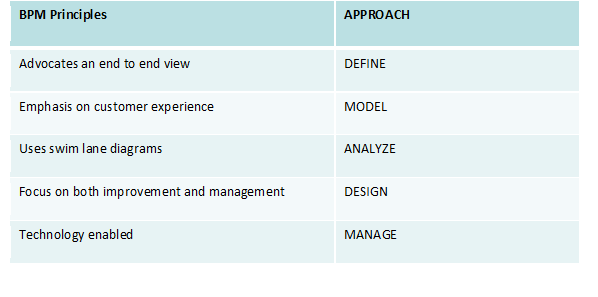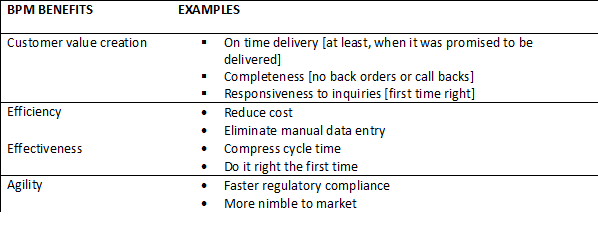What is the value proposition of BPM and how do I communicate to my senior leadership team is one of the most frequently asked questions on BPM.
In answering this question, the first order of priority is to ensure that people in the organization have a common shared understanding of BPM. In our view, BPM is not just modeling processes, it’s not just launching improvement projects, and it’s not just monitoring process performance for continuous improvement.
Instead, it is all three of these – in other words, the modeling, AND the improvement AND the management of the large cross functional processes in the firm.
Once, a shared understanding of the definition of BPM is achieved, it is then possible to outline the approach, benefits and pitfalls to avoid in BPM to demonstrate the value it can provide.
Some of the key principles and the general approach in BPM are outlined in Table 1 below:

Table 1: Selected BPM Principles and Approach
Outlining the benefits that accrue to organization who succeed with BPM is typically the next order of business. In some cases, it actually makes more sense to begin with the benefits and then outline principles and approach.
The typical benefits that are mentioned in making the case for the value proposition of BPM revolve around customer value creation, improved efficiency and effectiveness and greater agility.
Some examples of how BPM benefits might be communicated are outlined. Note however that this will vary in accordance with what is most critical to the company. What’s important is to weave a story around the factors that will most resonate with the leadership team.

Table 2: BPM Benefits
In addition to making a compelling case for the benefits that will be realized through BPM, it’s also important to outline the pitfalls to avoid. These include the following:
- Lack of linkage to strategy: BPM is a strategic approach and should be used to tackle the organization’s major issues. Important to avoid having too many small projects.
- Lack of having the right people involved: The best BPM projects are cross functional and requires the right
- Lack of baseline – wishy washy goals: BPM success needs to be measured. If you can’t measure it, you can’t manage it.
- More focus on technology than on cross functional collaboration: Technology is important – but it an enabler – and not the central focus of BPM
- Insufficient attention to people, culture and continuous improvement: Self evident
Achieve a shared understanding of the definition of BPM, and then outline the approach, benefits and the pitfalls to avoid. These are the steps needed to demonstrate the value of BPM. How it’s done is the magic recipe. Compelling stories are part of the recipe. Add a pinch of credibility, energy and excitement and you may well earn the support of the senior leadership team.

















